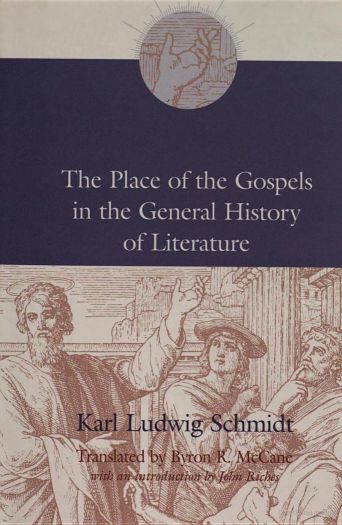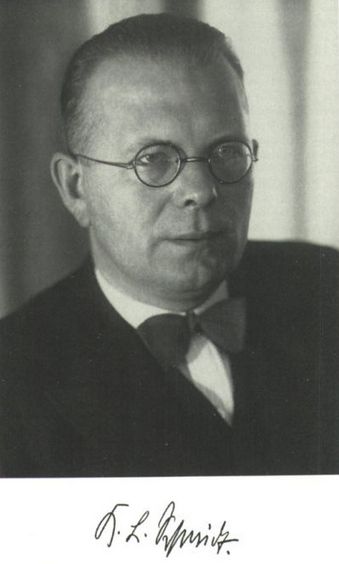Part 3: K. L. Schmidt: Placing the Gospels
When it comes to the form critics, NT scholars don’t know Schmidt. But to be fair, for a long time — all of the twentieth century in fact — they had a reasonable excuse. None of Karl Ludwig Schmidt’s works had been translated into English, and unless you could grapple with his dense, rambling, arcane German prose, you had to rely on reviews and summaries from bilingual scholars.

in the General History of Literature
Karl Ludwig Schmidt
An act of parricide
In 2002, however, one of Schmidt’s major works became available to the English-speaking public. Anyone with an interest in the gospel genre debate now has easy access to The Place of the Gospels in the General History of Literature at popular prices. I’m assuming it didn’t sell well, because right now it’s going for $2.45 (US) at Amazon, and when my copy arrived back in February, it had a black mark across the top. It has landed in the book equivalent of the cut-out bin.
If you have any interest at all in form criticism or NT German scholarship, John Riches’ introduction alone is worth the price of the book. Riches notes that it took an unconscionable amount of time for The Place of the Gospels to be translated into English.
The appearance in English, nearly eighty years after its first publication, of one of the major works of early-twentieth-century German gospel criticism, represents yet another triumph of the persistence of the few over the indifference and hostility of the many. In this way, Schmidt’s article in the Eucharisterion Festschrift joins William Wrede’s Messianic Secret (1901: 1971) and Rudolf Bultmann’s History of the Synoptic Tradition (1921: 1961) as works that have waited too long before they were made available to those without easy access to German. This leaves Der Rahmen der Geschichte Jesu [The Framework of the History of Jesus] as the last of the major works of the form critics still to be translated. Is this too little too late, or is there still an opportunity for a serious appraisal of the form critics? (p. vii, bold emphasis added)
We’ll save Riches’ strong criticism of current scholarship for a later post. For now, let me pique your curiosity with some choice words about how the work of the form critics has been twisted to serve antithetical purposes.
Thus a movement within the discipline that has firm roots within the tradition of form-critical studies of the gospels ends up, by a strange sleight of hand, by denying its origins. One might have expected a fuller account of this parricide; in practice what is offered is usually no more than the briefest dismissal of the main tenets of the form critics with little attention to the wealth of detailed argument with which they were supported. (p. x, bold emphasis added)
We have seen this before, time and time again, in modern biblical scholarship. They don’t know Wrede. They don’t know Wellhausen. And they certainly don’t know Schmidt.
Background
Since the beginning of the “scientific” study of the New Testament, scholars have argued over the genre of the gospels. Should we look for their antecedents in Jewish writings, Greek writings, both, or neither? If you read historical summaries by current scholars, they’ll tell you that Ernest Renan was the first to make the (in their view correct) assumption that the gospels are biographies. Richard Burridge writes:
The . . . introduction [to The Life of Jesus] reveals that Renan’s main sources are the four canonical gospels, assumed to be biographies, with the evangelists as the biographers of Jesus. Furthermore, the gospels belong to a subgroup of the wider genre of biography: ‘They are neither biographies after the manner of Suetonius, nor fictitious legends in the style of Philostratus; they are legendary biographies.’ (p. 4, What Are the Gospels?, emphasis added)
Often, Clyde Votaw gets the credit for first suggesting that the gospels are specifically Hellenistic biographies. You can read his 1915 article at the Internet Archive. Burridge and Charles Talbert (What Is a Gospel?) agree. Talbert concludes:
Votaw and Renan recognized the similarities between the gospels and Graeco-Roman biographies and assumed they belonged to the same genre. (p. 2, Talbert)
Today the consensus appears to be nearly unanimous. Curiously, the notion of a gospel fitting into a genre is, we are told, quite recent. In Dictionary of Jesus and the Gospels, Larry Hurtado writes:
The question of the genre of the Gospels is basically a modern issue, characteristic of the modern historical investigation of the NT. Our cultural and chronological distance from the first-century setting and our modern desire to overcome this distance through accurate knowledge of the past fuel the attempt to analyze the Gospels in their literary context. (p. 277, emphasis added)
Framing the issue this way could lead the casual reader to think the question had never arisen until the 19th century, and that Hurtado’s “modern desire” is driven purely by the quest for “accurate knowledge of the past.” But of course the question of genre was an ancient issue, too. In How Did Christianity Begin? Michael Bird reminds us that Justin Martyr categorized the gospels as “memoirs”:
This designation has obvious affinities with the “Lives” written about ancient figures, including Xenophon’s Memorabilia, which is a biographical account of the life of Socrates, Philo’s Life of Moses, Tacitus’ account about his father-in-law, Agricola, and Lucian’s Life of Demonax. The most analogous genre to the gospels, then, is the Bios or Vita, which is essentially a biographical narrative about a particular individual. (p. 104)
Bird cites Burridge, of course, but Burridge himself never mentions Justin’s apologia in What Are the Gospels? Schmidt, however, does mention him. Of Justin he writes:

He was in the unenviable position of having to make the gospel (peculiar as it was) understandable as literature not only to non-Christian bystanders but also to himself, because in an important sense the gospels — the “so called” gospels (ἄ καλεῖται εὐανγγέλλια;τὸ λεγόμενον εὐαγγἐλλιον) — were strange to Justin too. (p. 10, emphasis added)
Moreover, Schmidt explains, it was important for Justin to categorize the gospels as such, in order to raise their status:
In Justin the apologetic outlook is decisive; he is determined to elevate the cultural level of Christianity, and to that end he employs the designation “memoirs” to locate the gospels in high literature. (p. 10, emphasis added)
Theodor Zahn was more than happy with Justin’s assessment. Schmidt quotes from Zahn’s Geschichte des neutestamentlichen Kanons:
Zahn . . . asserts, “The name was excellently chosen and aptly suited to give literary-minded Gentiles the right picture of the genre of the Gospels.” But there is something else that matters even more to Zahn: for him the apomnemoneumata is the surest confirmation of the reliability of the Gospels, since it means that they must have actually been “memoirs” of the apostles, just like Xenophon’s “memoirs” of Socrates. (p. 10, emphasis added)
Misconceptions
I suggest that this result is not an accident.
We’re barely out of the starting gate and we’re already confronting misconceptions that will plague us throughout this study. The urge to categorize the gospels in order to make them understandable, respectable, and authoritative emerged almost from the start. We did not have to wait for modern scholarship’s keen critical eye. Naturally, if your goal is to prove that the gospels are biographies, it’s more palatable to cite Renan, a respected modern scholar, first, rather than Justin, whose motives were clearly centered on Christian apologia.
Furthermore, Zahn’s motives persist today. If we wish to know anything about the historical Jesus, we must rely solely on the gospels. But how reliable are they? If we categorize them as memoirs, histories, or Graeco-Roman biographies, we imbue them with implicit reliability and an air of authenticity. I suggest that this result is not an accident.
In our next installment, we’ll continue with Schmidt’s thesis, covering the terms Hochliteratur and Kleinliteratur.
If you enjoyed this post, please consider donating to Vridar. Thanks!

It would seem that anglophone scholarship, even when critical of historical Christian orthodoxy, has been careful to keep the academic world safe for orthodoxy.
Schmidt’s book was unfortunately one of the first books I read when taking up a serious interest in biblical studies. I say ‘unfortunately’ because I see now I read it too soon, that is, before I understood as much of the New Testament scholarly background as I have come to grasp since, some years before I started this blog. Your posts have prompted me to return to that book and I see now where I marked references to the clearest arguments that knock out any notion that the Gospels could be compared with ancient biographies. I have used some of these arguments since but had forgotten that Schmidt was most likely their source. I’m so pleased you are doing this series. I will revise my own reading of Schmidt as you post.
It could have been worse – my very first book on Christianity was Dom Crossan’s “The Historical Jesus: The Life of a Mediterranean Jewish Peasant”.
It impressed -then.
It’s fortunate, I suppose, that the very first book on critical scholarship I ever owned was Perrin’s The New Testament, an Introduction; Proclamation and Parenesis, Myth and History, which I bought back in 1978 for a course at Ohio University. I still have it, as well as the Oxford Study Edition of the New English Bible. Sometimes I think I should get a newer version of the Perrin book; it was used and the previous owner had marked it up pretty heavily. My notes in the NEB look a little childish to me now, but it was after all 35 years ago. (Holy crap.)
On the subject of Schmidt, a few months ago I was writing a post or a comment in which I was about to use the term “pearls on a string” for the hundredth time. I couldn’t recall who first coined the phrase, Googled it, and to make a long story short, I ended up with the question, “Why don’t I own anything by Karl Ludwig Schmidt?” And that’s when I discovered that his work — like Bultmann’s and Wrede’s — had suffered from an Anglo-American blackout for decades.
There are parallels here with Wrede. Current scholars use them both as footnote fodder, but clearly haven’t read the original work. They accuse them both of working from preconceptions, but when you study the actual material you find that the so-called preconceptions are actually the results of careful analysis. They’re dismissed as “old thinking.” The distorted summaries of their works have become the common “tradition.” (Here’s an idea for consideration: Does NT scholarship have its own oral and written tradition? How has that tradition changed over time to fit new norms old agendas?)
In the really hard-core apologetic seminaries, Wrede, Bultmann, and Schmidt (if Schmidt’s name ever comes up) are skeptical Germans, so students can pretty much learn their names, memorize a few quotes, absorb the received counter-arguments, and move on.